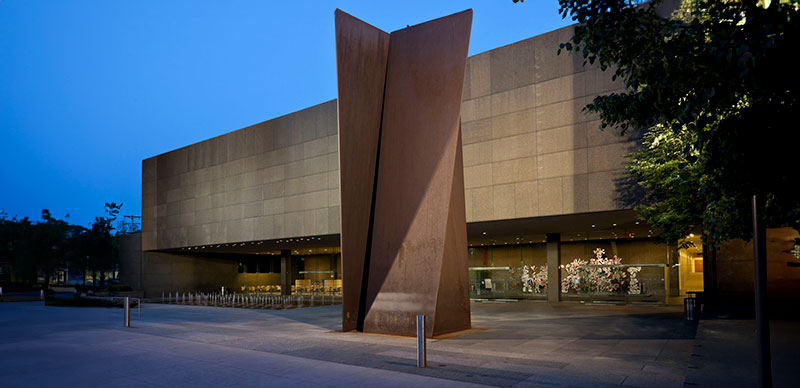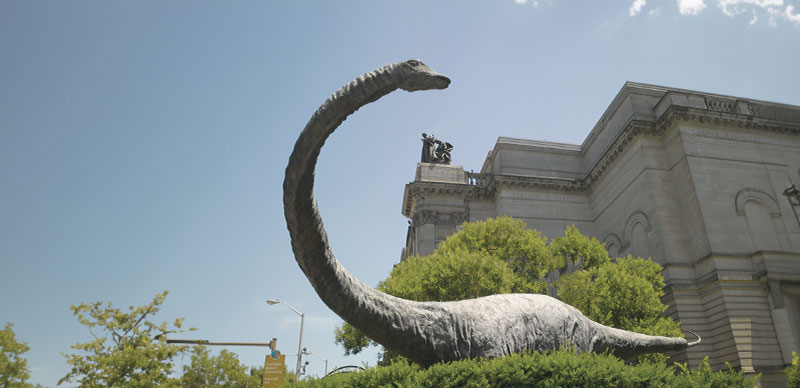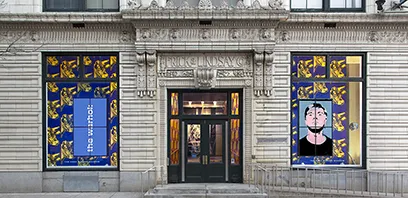A Carnegie curator reveals the history contained in three objects obtained from
the annual Antiques Show
By Sarah Nichols
In recent years the annual Antiques Show at The Carnegie has regularly provided
the Decorative Arts Department of the Carnegie Museum of Art with an opportunity
to add to its collections, particularly in the area of ceramics. Several objects
acquired over the last three years reveal intriguing ties to English public affairs
of the past. These objects include a salt-glazed stoneware tankard, c. 1740, a Chinese
export porcelain punch bowl from c. 1770, and an earthenware coin bank from Staffordshire
in the form of a country house from c. 1813. While the stoneware tankard and the
export punchbowl are overtly political, the earthenware bank offers an indirect comment
on old tax laws.
The 1740 tankard has finely detailed molded decoration commemorating Admiral Edward
Vernon’s victory over the Spanish at Portobello, Panama, in 1739. An outspoken military
and political leader who criticized Spanish colonial policy in the 18th century,
when the British empire was expanding its influence, Vernon boasted that he could
capture Spain’s rich outpost at Portobello, which was Spain’s Caribbean port for
the shipment of riches from the New World and the Pacific islands to the Spanish
Crown. This he accomplished with the loss of very few seamen.
He returned to England a national hero and the Staffordshire potteries lost no
time in producing souvenirs to celebrate his exploits. This large tankard with its
three panels shows the port of Portobello, the royal coat of arms, and a head-to-
toe portrait of Vernon. Vernon’s fame was various: he was called “Old Grog” by sailors
for his practice of reducing drunkenness by mixing water with the sailor’s ration
of rum (a policy later adopted by the navy), and he lives on in American history
through the naming of Mount Vernon, George Washington’s home in Virginia. Washington’s
half brother, Lawrence, served under Admiral Vernon, and named the family estate
after him
This 1740 tankard is important in the history of ceramics in England. The refined
detailing of its design could only be achieved by the technique of slip casting
using porous plaster of Paris molds. By this technique the slip (i.e.,watered clay)
was introduced into plaster of Paris molds which absorbed the water from the clay,
leaving a fine surface for firing. This technique seems to have been introduced in
Staffordshire in 1740, exactly at the same time that Vernon was at the height of
his popularity. The Portobello pieces are considered one of the earliest documented
examples of the use of this technique.
Made in China several decades after the tankard, the Chinese export porcelain
punch bowl was created specifically for the English and American markets. The bowl
features a picture of the English political radical John Wilkes, who supported economic
and parliamentary reform and the independence of America. His figure is on the left,
and on the right-flanked by Satan, chains, a serpent and the inscription “justice
sans pitie”-is Judge Mansfield, his adjudicator. In 1763 the outspoken Wilkes offended
the King with a critical article in his paper, North Briton, and was arrested and
taken to the Tower of London. He was later released, but he was found guilty of libel,
and to escape further imprisonment he fled to France and Italy. In 1768 he returned
to England and was again elected to Parliament by a large majority. His popularity
was undiminished, although he was expelled from the House of Commons and not allowed
to take his seat. The decoration on this bowl was copied in China from a printed
broadsheet issued in London in June of 1768. The impending conflict between Britain
and America, and Wilkes’s renewed electoral struggles in 1772, heightened the popularity
of these bowls on both sides of the Atlantic. They were prized by those who hailed
Wilkes as a champion of liberty.
Third in this series of commemorative English ceramics is a large earthenware
coin bank, dating some four decades after the porcelain punch bowl. The bank has
two slits for depositing money on the back of the roof, and closely resembles one
inscribed “New Hall China Manufactory Staffordshire 1813.” This factory was based
at Shelton Hall near Hanley in Staffordshire, and the form of this bank may derive
from that building. Later the house and therefore the factory acquired the name “New
Hall” to distinguish it from the two other Shelton Halls in its vicinity. This model
is particularly large for use as a ceramic bank, suggesting that it was clearly ceremonial
rather than functional, and was probably produced in 1813 to celebrate an important
occasion in the factory’s history. The only way to retrieve coins from the bank is
to break it.
The blocked-up windows on the ground floor of the house are significant. Why bother
to reproduce blocked windows in a ceramic model, unless they were truly characteristic
of the house? One explanation is that in this house-turned-factory the ground floor
was used for manufacturing, hence the ground floor windows were permanently blocked.
But another explanation is that, since in 18th-century England glass windows were
taxed as evidence of wealth, the blocked windows reduced the owner’s taxes. Whatever
the explanation, the closed windows are seen on every example of this large earthenware
bank.
Knowledge of 200-year-old public events can add interest to fine ceramics such
as these, but is simply one of many reasons why collectors and curators enjoy the
antiques show at The Carnegie. More than 40 dealers who exhibit have antiques for
all tastes and all budgets, not only the Museum’s. Curators who patronize the show
have an ongoing competition to find the least expensive object for sale-a record
currently held by a silver teaspoon priced at six dollars. The teaspoon was quickly
snapped up. The show is also a wonderful opportunity to browse, enjoy the spectacular
setting and acquire new decorating ideas. For those who want first choice of what
is offered, the preview party on the evening before the opening is a must. Expect
the curators of the Decorative Arts Department to be there, searching for new treasures
for the collection.
Sarah Nichols is curator of the Department of Decorative Arts at the Carnegie
Museum of Art
A Glimpse of English History in Ceramics (Mar/Apr 1996)
A Carnegie curator reveals the history contained in three objects obtained from the annual Antiques Show By Sarah Nichols In recent years the annual Antiques Show at The Carnegie has



